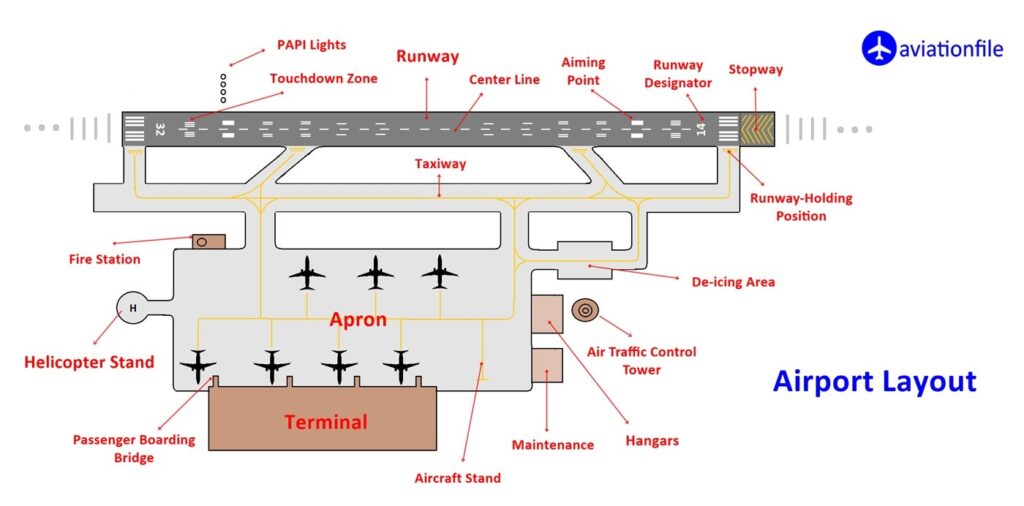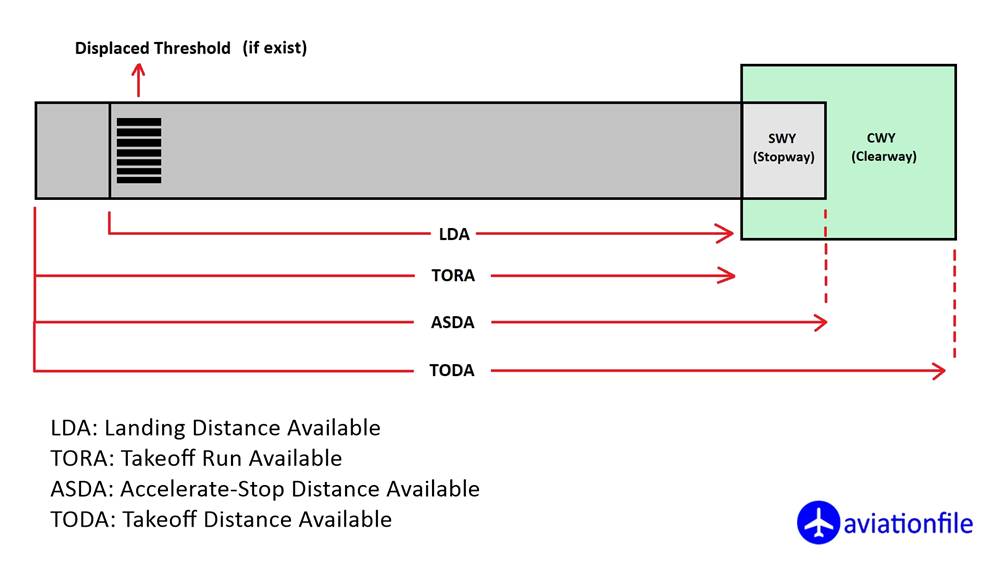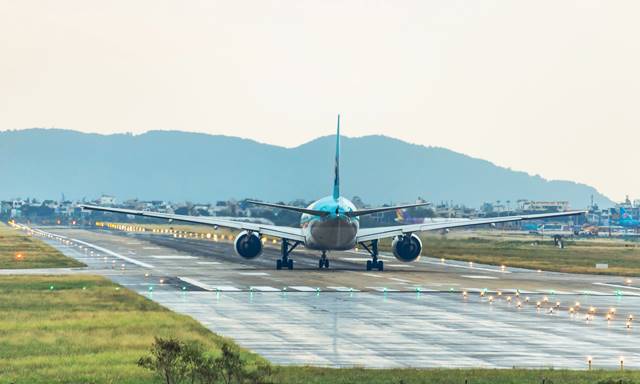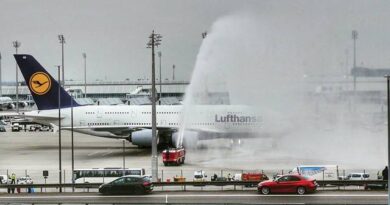TORA, TODA, ASDA, LDA, Clearway And Stopway Explained
If you’ve been wondering about the meanings of aviation terms like TORA, TODA, ASDA, LDA, clearway, and stopway, your search ends here. In this detailed guide, we will clarify these critical concepts in aviation. Understanding these terms is essential for pilots, air traffic controllers, aviation enthusiasts, and industry professionals to ensure safe and efficient aircraft operations. By the end of this article, you will have a thorough grasp of each term and its significance in the context of runway design and aircraft performance.
When it comes to aviation one thing is certain, it is serious business. Whether you are a commercial pilot responsible for the safety of your crew and passengers through the whole flight or you are simply an aviation enthusiast training to get your certificate in order to experience the beauty of the skies firsthand, precision is key! So, no matter how confusing these aviation terms may seem at first glance, they are fundamentally important to know for anyone who is going to operate an aircraft.
TORA – TODA – ASDA – LDA – Stopway – Clearway
Simply put, clearway, stopway, TORA, TODA, ASDA, LDA are specific parts and extensions of a runway, which is basically the area used for the landing and takeoff of an aircraft.
- TORA (Take off Run Available),
- TODA (Take off Distance Available),
- ASDA (Accelerate Stop Distance Available),
- LDA (Landing Distance Available).
Because each one of these areas have different structures, very precise sizes and distinct purposes during landing and takeoff, it is crucial to know the definition and characteristics of every single one of these terms for taking off and landing safely.
Whether you are an aspiring flight enthusiast trying to get a grasp on the parts of runways or you simply want to refresh your memory about these basic aviation terms, this article is going to help you. In this post we will learn about TORA, TODA, ASDA, LDA, clearway and stopway. Although it may seem a little bit confusing at first, the figure you can find below that shows how each area is related to the other parts will help you get a better understanding.
So, let’s learn more about these important aviation terms starting with the definition of “runway”.
What Does “Runway” Mean?
According to the ICAO (International Civil Aviation Organization), the meaning of a runway is “defined rectangular area on a land aerodrome prepared for the landing and takeoff of aircraft“, which basically means that it is the area used specifically to takeoff and land an aircraft.
The dimensions of runways vary a lot, they can be as small as 245 m (804 ft) long and 8 m (26 ft) wide, as seen in smaller general aviation airports and as large as the lake bed runway 17/35 at Edwards Air Force Base in California with huge dimensions of 11,917 m × 274 m (39,098 ft × 899 ft).
Asphalt, concrete, and even a blend of both, these are the special materials that give runway surfaces their strength and durability. On the other hand, in some of the domestic airfields around the world, runways may simply be natural surface such as grass, dirt, gravel, ice, sand or even salt. While meters represent the standard unit for runway measurements globally, North American practice typically converts these dimensions to feet.

The Definition Of Clearway
Clearway is the part of runways located beyond the paved part, it is free of all types of material that can be regarded as blockage and it is controlled by airport authorities. The length of this part may be counted as a part of the length of TODA, which we will define later on in this post.
According to The U.S. Department of Transportation Federal Aviation Administration, the clearway has to be at least 150 meters (500 ft) wide and the practical limit for clearway length is 300 meters (1,000 ft). The clearway is crucial for the successful execution of takeoff.
The Meaning Of Stopway
The stopway is the area that is placed right after the runway and it is used when reducing speed if a takeoff is called off for any reason. Its width has to be at least the same as the runway and it should be able to help a plane slow down without damaging it. The stopway is centered on the runway extended centerline and the combined length of runway and stopway equals the ASDA, which is Accelerate Stop Distance Available.
Because they have limited use and are expensive to build, stopways are less cost effective in comparison to a full-strength runway that is functioning in both directions. The presence of prominent yellow chevrons on the runway extremities indicates the location of stopways.
TORA (Take off Run Available)
TORA is defined as the length of runway suitable for takeoff run of an aircraft. If there is a displaced threshold, TORA is not equal to LDA (Landing Distance Available). On the other hand, TORA does not include the stopway or the clearway. TORA is 15% shorter than the whole runway length.
TODA (Take off Distance Available)
TODA is the length of runway plus any clearway if exists. In case that there is no clearway, TODA is same as TORA. TODA includes ground as well as air segments.
In short, TODA = TORA + Clearway.
ASDA (Accelerate-Stop Distance Available)
ASDA is defined as the sum of LDA/TORA (as applicable) and Stopway. In case that the takeoff is aborted, the aircraft can be brought to a stop either on the runway or on the stopway. In case of aboted takeoff ASDA must not be used as TORA because of the structure of the clearway area.
LDA (Landing Distance Available)
LDA is the portion of runway length declared available and suitable for landing of an aircraft. If there is a displaced threshold, LDA starts from the beginning of displaced threshold. Otherwise the beginning of the threshold is the beginning point of LDA.
Aerodrome Information Publications and Jeppesen Charts provide detailed information about runways, including clearways, stopways, TORA, TODA, ASDA, LDA, and more.

The Importance Of Runway Declared Distances
These lengths and values are very important for aerodrome authority, Air Traffic Controllers of the airport and the Pilots. The main aim is to protect the safety and wellbeing of the crew and the passengers. And achieve a successful takeoff and landing.
There are various types of aircraft in several different categories and all of them have minimum requirements. An airline company has to fulfill these requirements to build a safe destination suitable for landing and taking off without risk.
From an air traffic controller side, the ATC must know all the lengths with intersection takeoff values in order to maintain the security of the air traffic and ensure the safety of everyone involved. In the end, all the technical details, rules and regulations in aviation serve primarily one purpose and it is; “safety”.
A Short Summary
In aviation, precision is important and fully understanding the meaning of several key terms is very crucial. The parts and extensions of runways are among these basic terms. And they can be listed as; clearway, stopway, TORA, TODA, ASDA and LDA. It is absolutely necessary for a pilot to know the runway declared distances and operational requirements of the aircraft they are operating to takeoff and land safely. To briefly describe these
important terms;
• Airports designate runways for aircraft to take off and land.
* Clearway is the part of runway located beyond the paved part that is free of all types of obstructive material.
• In case of a cancelled takeoff, aircraft utilize the stopway to safely decelerate.
* The runway provides TORA, the length available for the takeoff run.
• TODA is TORA plus clearway when available.
* ASDA is TORA plus stopway when available.
• Airplanes can use the Landing Distance Available (LDA) for their landing ground run.
References and Further Reading:
- Annex 14 – Aerodrome Design and Operations: https://www.icao.int/APAC/Meetings/2015%20WAWG1/an14_1ed_1951.pdf
- Doc 9983 – Airport Design Manual: https://www.bazl.admin.ch/dam/bazl/de/dokumente/Fachleute/Flugplaetze/ICAO/icao_doc_9683_human_factors_training_manual.pdf.download.pdf/9683_cons_en.pdf
- AC 150/5340-1G – Standards for Determining Runway Length Requirements for Airport Design: https://www.faa.gov/airports/resources/advisory_circulars/index.cfm/go/document.current/documentnumber/150_5340-1
- JO 7340.1M – Procedures for Handling Aircraft Emergencies: https://www.faa.gov/regulations_policies/handbooks_manuals




I have been struggling to understand declared distances. Now its all clear. Thank you so much.
It would be nice to offer a few examples of each, e.g. ” An airport may have a gravel portion available at the approach end which is suitable for landing with sufficient surface load bearing available, and which does not present any risk of prop damage to aircraft at threshold crossing airspeed and low power settings. Because it would likely present significant damage to propellers at the beginning of takeoff roll, it is unsuitable for that use. This would be an example of…, etc. “
Thank you for your suggestion and comment. Will consider adding examples for next updates…